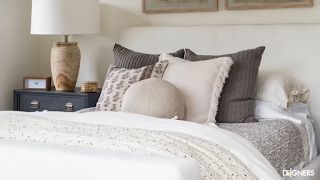TOP 15 BEDROOM MISTAKES & How To Fix Them Immediately | Interior Design & Home Decor
Designing a bedroom is not just about aesthetics—it’s about creating a space that reflects your personality, promotes relaxation, and offers functionality. However, certain common mistakes can detract from your bedroom’s potential. Let’s dive into these pitfalls and how to avoid them.
1. Choosing the Wrong Colors
Colors play a significant role in shaping the mood of a room. While vibrant tones like red, yellow, or orange might look appealing, they can feel overwhelming in a space meant for rest. Intense hues can disrupt the calming vibe needed for relaxation.
Solution:
Opt for warm or cool neutrals and nature-inspired tones like soft green, pale blue, or dusty pink. If you love bold colors, use them sparingly in accessories like cushions or throws rather than on walls or large furniture pieces. This approach ensures a timeless and relaxing bedroom.
2. Mismatched Nightstand Heights
A nightstand that’s too high or too low compared to your bed can be impractical and uncomfortable.
Solution:
The ideal height for a nightstand is no more than four inches above or below your mattress height. Measure your bed’s height, including the mattress, and choose a nightstand accordingly. This is especially critical if you have minimalist or Japanese-inspired low furniture.
3. Ignoring the Focal Point
Every bedroom needs a focal point, and more often than not, it should be the bed and its headboard.
Solution:
Emphasize the bed by choosing a striking headboard or decorating the wall behind it. Options include wallpaper, a contrasting paint color, wood paneling, or a gallery wall. This creates visual interest and balance in the room.
4. Overemphasizing Symmetry
Symmetry can be visually pleasing, but it’s not the only way to design a bedroom. Matching furniture and decor on both sides of the bed isn’t always necessary.
Solution:
Experiment with asymmetry. Use different furniture pieces on each side of the bed, such as a nightstand on one side and a bench or floating shelves on the other. Ensure balance by maintaining similar visual weight on both sides.
5. Poor Window Treatments
Inadequate window treatments can allow light pollution to disturb your sleep or fail to provide privacy.
Solution:
Install blackout curtains or roller blinds to block external light at night. Use layered treatments, such as sheer curtains for daytime privacy and blackout panels for bedtime, to create the perfect environment for rest.
6. Matching Furniture Sets
Buying furniture as a matching set might seem convenient, but it often results in a lack of personality and creativity.
Solution:
Mix and match different pieces to add character and variety. Combine shapes, textures, and colors for a unique and modern look that reflects your personal style.
7. Harsh or Cool Lighting
Lighting with a cool temperature or direct glare can disrupt your circadian rhythm and affect your mood.
Solution:
Use warm-toned bulbs and lamps with diffusers to create a cozy atmosphere. Place lighting at eye level, such as on nightstands or dressers, for a soft and relaxing glow.
8. Rugs That Are Too Small
A small rug placed at the foot of the bed isn’t practical or visually pleasing.
Solution:
Choose a larger rug that extends at least 20 inches beyond the sides of the bed, or use runners on each side. This ensures the first thing your feet touch in the morning is a soft, comfortable surface.
9. Lack of Layered Textures
A bedroom without layered textures can feel flat and uninviting.
Solution:
Incorporate a variety of textures with bedspreads, cushions, and blankets. Use materials like velvet, linen, or knits to create depth and warmth.
10. Insufficient Circulation Space
Crowding your bedroom with furniture can make it feel cramped and uncomfortable.
Solution:
Leave at least 25-35 inches of clearance around the bed and other furniture for easy movement and accessibility.
11. Ignoring Personal Style
Copying a design trend without considering your preferences can result in a space that doesn’t feel like home.
Solution:
Design with your personality in mind. Choose colors, textures, and decor that resonate with you. Whether your style is minimalist, bohemian, or classic, make your bedroom a true reflection of your taste.
12. Overusing Bold Patterns
Too many bold patterns can overwhelm the space and make it feel chaotic.
Solution:
Use prints sparingly, focusing on organic shapes and soft colors for larger elements like curtains or bedding. Add patterns through small accents for a balanced look.
13. Oversized Beds
A bed that’s too large for the room can dominate the space and make it feel cramped.
Solution:
Choose a bed size appropriate for the room’s dimensions. Ensure there’s at least 25-35 inches of clearance around the bed, and position it against the longest wall.
14. Blocking Natural Light
Placing furniture, especially the bed, in front of windows can obstruct natural light.
Solution:
If possible, reposition furniture to maximize natural light. If this isn’t an option, use low-profile headboards and lightweight curtains to maintain light flow.
15. Trendy Bedding That Doesn’t Match
Trendy bedding with bold designs might not blend well with the overall decor and can quickly go out of style.
Solution:
Invest in high-quality bedding with neutral tones or subtle patterns. Add pops of color or prints with accessories like cushions or throws for versatility. By avoiding these common mistakes and implementing these solutions, you can create a bedroom that is not only stylish and functional but also a sanctuary that promotes relaxation and comfort.


















